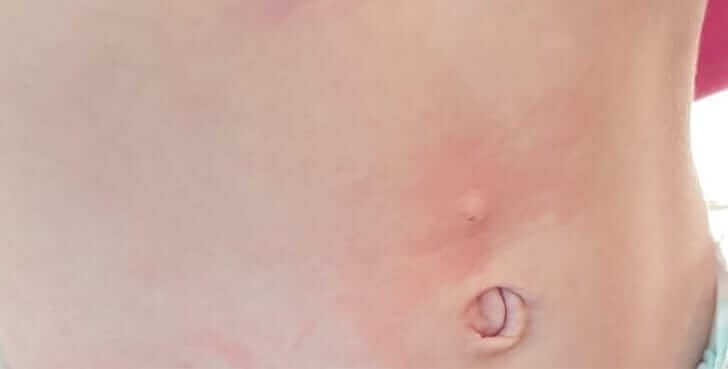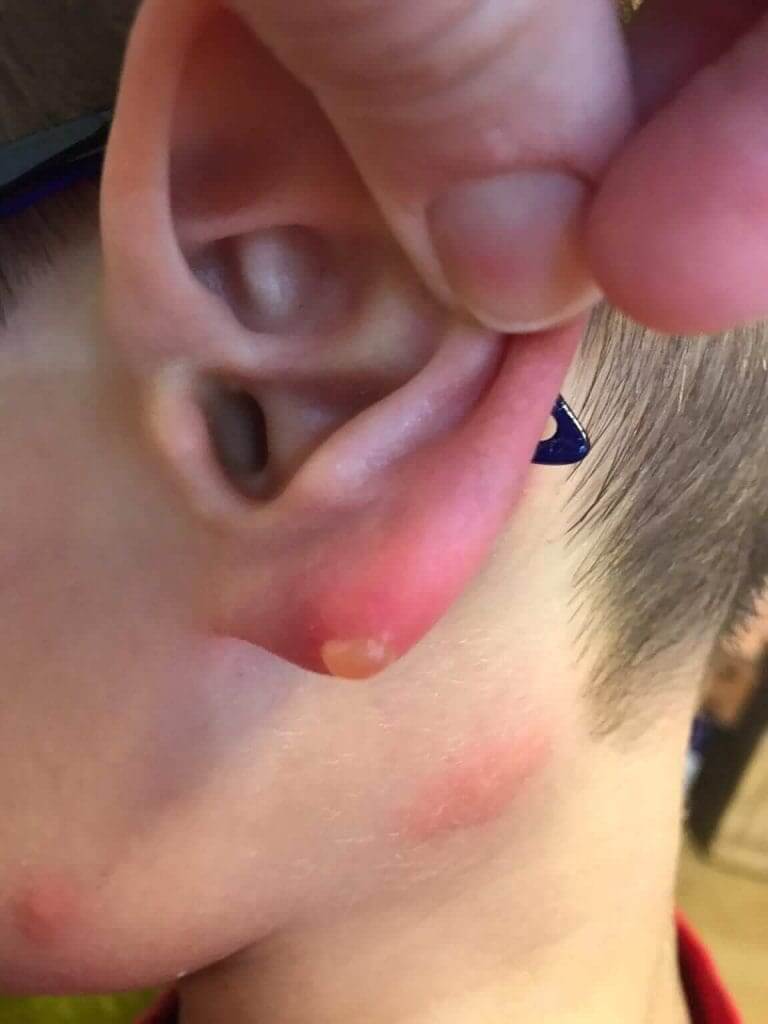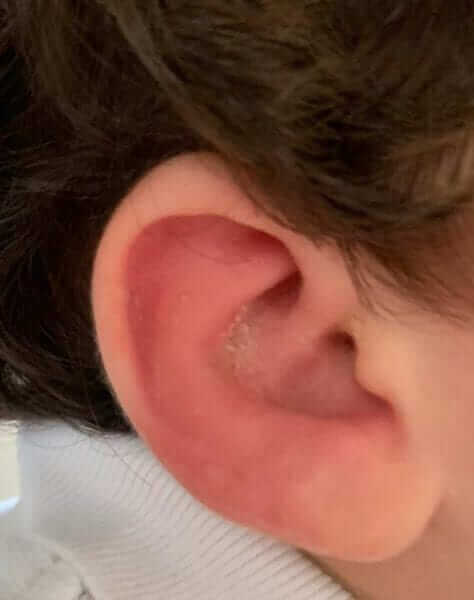
Bites in children (mostly mosquitos some insects and a few bees)
The confusion in the subject is so prevalent that some clarifications should be made.
Therefore, the purpose of this article is to clarify the different local reactions, especially to bites. The article does not focus on significant systemic reactions such as genuine bee stings, which should be addressed separately.
In one chapter it is impossible to address all types of bites from all insects around the world, so I will deal here with the most common ones.
Does every local reaction to a bite actually express an allergic reaction?
Definitely not. Imagine that a small amount of venom gets under our skin. Venom contains components that create a local inflammation response and therefore the area will be sensitive and swollen. However, this is not an allergic reaction, but just a local inflammatory reaction to the venom.
Only in some cases a bite can lead to a local allergic reaction. In a minority of cases (mostly in bee stings), it can also lead to a significant turbulent reaction in an allergic mechanism.
Therefore, although I heard on a numerous occasions that “my child is allergic to mosquito bites”, I hope that now it’s clear that the child is not actually allergic. Perhaps the semantics doesn’t make a difference as the management of treatment is quite similar.
How to divide the reactions to mosquito bites (and more):
Local reaction – is the most common, especially in mosquito / insect bite. The affected area will appear red and swollen for up to 24 hours.
Large local reaction – less common after simple bites (insect or mosquitos), and more common after bee sting. This refers to a local reaction which involves the area of the bite as well as the area around it which is over 10cm. Usually a large local reaction spreads between 6-12 hours after the bite, progresses during the first 24-48 hours and can last for days. In many cases the child will be given antibiotics due to a false suspicion of secondary bacterial infection of the bitten area.
Large / spread skin reaction – usually develops rapidly after a bee sting and can include itching and skin findings which go with allergy (urticaria) and not only in the bite area. In such cases there is room to discuss with the physician about consulting an allergist.
Systematic reaction – can develop after a bee sting and includes a spread skin reaction (urticaria and angioaedema), edema of the respiratory organs up to shock. In these cases, your local physician should be consulted and consultation with pediatric allergist is needed.
Toxic reaction – a bite by several creatures (for instance- a swarm of bees), can lead to a reaction of fever, fatigue, vomiting and even death.
Delayed reaction – there can be late reaction to bites that can involve any organ of the body. This is not common.
How can a reaction to bites be diagnosed?
The classic skin reaction to bites will appear as shown in the upper photo and is called wheal and flare reaction. Wheal refers to the white centred lesion and flare describes the expansion of the blood vessels around, the “hot” red area shown in the picture.
Sometimes a bite area can seem as a single or several blisters.
See the second photo 2 – this is called Bullous insect bite.
Are there children who more susceptible to mosquito bites than others?
Yes, although it is not an allergy. The reaction is individual. Some will have a minor reaction and others will suffer from or more significant reaction. Those who rub the bites worsen the reaction.
In addition, atopic children have the tendency to have a slightly more significant local reaction to mosquito / insect bites.
On the other hand, there is a syndrome called Skeeter syndrome that expresses a significant skin reaction to mosquito bites. Often it is confused with bacterial skin infection.
Can mosquito bites cause more than a local reaction? Do mosquitos transmit diseases?
Mosquito is the deadliest animal in nature. But fortunately, Malaria which is the deadliest disease transmitted by a mosquito bite exist only in specific areas of the world.
There are other diseases that mosquitos in our area can transmit but there are less common and will not be included in this article.

A bite around the ear
It is very common to see a swollen, red and erect bite followed by a minor bite. From my experience, an ear such as this stressed parents very much. It is important to remember that it is sometimes difficult to see the location of the bite whilst the ear is swollen.
On the other hand, a bacterial infection in the cartilage of the auricle (Perichondritis) is considered a significant bacterial infection that justifies aggressive antibiotic treatment and therefore the two should not be confused.
How can we tell when its just a local reaction to a bite or it is a bacterial infection? as both appear swollen, hot and read (see photo).
We should squeeze the child’s ear. In case of a local allergic reaction this will not cause pain to the child. In case of an infection, the squeeze will almost be impossible because it will cause severe pain.
In case of a bite, it can be treated like any other bites. See below.
In case of doubt or continuous redness, see a physician.
A bite in the area around the eye
Similar to a bite around the ear, swelling in the area around the eye can worry parents. Here too, one should not mistake a normal reaction to a bite with significant bacterial infection, called Orbital cellulitis. The difference is that in bacterial infection in the area will usually be very painful to the touch, red and in some cases will cause fever. Occasionally one might notice the bite, usually in the area of the eyebrow. Although in the primary stage of the swelling, it might be hard to detect so use this dedicated chapter in our site.
If in doubt consult a doctor.
How to prevent bites in children?
In families or children where bites are common, especially mosquito bites, the following measures are recommended:
– Water sources in the area of the house should be dried.
– Installing nets on the windows.
– Wearing long sleeve clothes.
– Turning on an air-conditioning in the nursery.
– Use of mosquito repellents suitable for the children’s age.
What’s the recommended treatment for mosquito bites in children?
Naturally, the treatment derives from the nature of the reaction to the bite.
The treatment of a mild local reaction to insect / mosquito / bee bites – is applying a cold compress, local anti-histaminic cream / gel to relief the itching and sometimes systemic antihistamines in drops / syrup / pill. Also in a case of a bite in the area of the eye or ear, a local soothing cream can be applied.
In order to reduce the chance of secondary infection (see below) an antiseptic cream can be applied. Also be sure to disinfect the hands and cut the child’s fingernails. In case the child rubs and hurts the skin, you can cover the bite with a plaster or gauze.
In a more significant reaction, certainly in bee stings, consult a physician and consider an allergist advice.
What to do in case a local reaction does not pass or when there is aggravation of the swelling and redness?
In the area of the injured skin there may be penetration of germs and a secondary bacterial infection.
Paradoxically, areas of bee stings and venom are less likely to get infected as the venom itself has properties that prevent bacteria to thrive. However, many of simple skin infections in children start with a simple bite that the child was rubbing and caused an infection.
In cases of secondary bacterial infection an antibiotic cream can be applied locally and in more complicated cases oral antibiotic treatment should be considered.

In summary:
This topic is very commonly discussed between parents and pediatricians. I hope that the information given in the article will contributed to parents’ knowledge on the subject.
For comments and questions, please register
